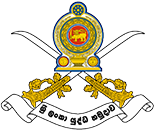 SECRETARY DEFENCE, Gotabhaya Rajapaksa says it was President Mahinda Rajapaksa’s determination that ultimately helped the Army defeat the Tigers. “President Mahinda Rajapaksa took several brave decisions. In the final analysis, it was the cumulative effect of those decisive, brave decisions that enabled Sri Lankan Armed Forces to liquidate the LTTE.”
SECRETARY DEFENCE, Gotabhaya Rajapaksa says it was President Mahinda Rajapaksa’s determination that ultimately helped the Army defeat the Tigers. “President Mahinda Rajapaksa took several brave decisions. In the final analysis, it was the cumulative effect of those decisive, brave decisions that enabled Sri Lankan Armed Forces to liquidate the LTTE.”
He says, “usually in a military operation the world outside the conflict theatre, domestic and international, see only soldiers fighting.
They see tanks, guns, armoured vehicles, artillery weapons and men and women in battle fatigues.”
“What is not visible to the people, to the outside world, is the strategy. What is also not visible immediately and also not recalled at that moment in time is the history that led to the current context of military operations. What was that context? Eight previous Governments led by four Presidents had failed to end the war. They had failed to rein in the LTTE. It is not as if those eight Governments and four Presidents did not have under their command good military leaders and soldiers. In fact, when President Rajapaksa’s Government assumed charge in 2005, around 26,000 soldiers had sacrificed their lives,” he adds.
Rajapaksa emphasises that political will is the supreme commander. He points to the successful operation, Liberation Vadamarachchi Operation from May to June 1987 and Operation Riviresa from October to December 1995 to suggest that there was no deficiency in the Armed Forces.
The Vadamarachchi Operation led to the recapture the Vadamarachchi from the LTTE control. This was the Security Forces’ first conventional combat engagement in Sri Lankan soil after the British colonial rule. During Operation Riviresa the SLAF launched a successful assault to wrest control of Jaffna and rest of the Jaffna peninsula from the LTTE.
Using these examples, Rajapaksa explains that if at all there was any deficiency then it was on account of inadequate, lax and effete political will.
He said, When President Rajapaksa assumed Office in 2005, we studied all previous war operations: Eelam War I (1976-1987); Vadamarachchi Operation; IPKF intervention; Eelam War II (1990-1995); Operation Sea Breeze; Operation Thrividha Balaya; Operation Balavegaya I, II; Eelam War III (1995-2002); Operation Riviresa; Operation Jayasikuru; Operation Rivibala; Operation Ranagosa; Operation Rivikirana; and Operation Kinihira I, II, III/IV, V/VI, VII, VIII, IX.
Crucial points in winning war
* Attention to detail
* Ability to arrive at clutter-free decisions
* Expansion of Armed Forces
* Backing formulation of new war doctrine
The objective was to arrive at conclusive reasons for our previous failures to comprehensively finish the war against the LTTE in the past 30 years. All four previous Presidents had resorted to military means and yet had failed. So a political decision was made by President Rajapaksa to comprehensively study all previous war operations and arrive at a solution for every factor of failure or inability to win the war. For every factor we found a solution, he said.
We found that there was really no failure factor attached to the military. In fact, we realized a simple fact in 2005, that if we launched war operations against the LTTE then we would have to fight with the same military that had fought the LTTE in the past 30 years. We were confident of winning with the same military and its Special Forces and Commandos.
They were already there! Yet, what explained the inability of the previous Governments led by four different Presidents to utilize the country’s military strength effectively?
He adds, We came to the conclusion that the solution was to increase the Force strength. The key factor of previous inability to finish the war was inadequate numbers. We realized the expansion of military would have a definitive impact on LTTE.
Therefore, the second decisive political decision was to expand the Armed Forces, he said.
President Rajapaksa’s and his advisors’ detailed and nuanced study of previous war operations was marked by two defining characteristics.
One was attention to detail and the second was their ability to quickly arrive at a clutter-free decision. The third important political decision was a natural corollary of the imperative to expand the Armed Forces.
The Defence Secretary says the decision to increase numbers actually enabled the Security Forces to address two previous failure factors. The first has already been discussed. The second was the previous inability of the Armed Forces to conduct war operations on a broad front and operate simultaneously across multiple frontlines.
When we cleared the Eastern Province, the LTTE said they were not defeated and that its Forces had merely staged a tactical withdrawal.
The LTTE was confident that the Army will not have the troop strength to hold the ground in the Eastern Province. Like all earlier occasions, the LTTE believed that if it opened sporadic operations along the Northern Frontlines then the Armed Forces will be forced to redeploy enabling LTTE to regain ground in the East. Several opposition party leaders, too, openly declared that the military operations in the East will not be sustainable.
We lulled everyone into believing that the previous status quo will prevail - that the Armed Forces will fight and win, then the LTTE will open a new front, and the Forces will redeploy and fail to hold ground and consolidate in the areas where they had attained victory - this would enable LTTE to regain control over lost areas. Little did the LTTE know that we had prepared a new war doctrine! That we were indeed prepared to fight war on a broad front, along multiple frontlines.
(Courtesy: Daily News/Indian Defence Review and Sify News India/To be continued)

